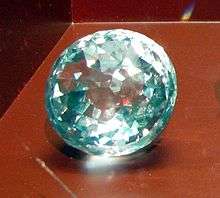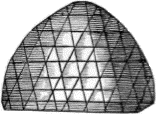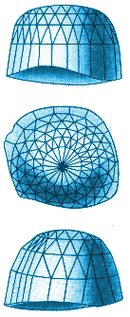Great Mogul Diamond
Great Mogul is believed to have been discovered around 1650 most probably around Kollur Mine in the Golconda region of southern India. Tavernier described the diamond as "The stone is of the same form as if one cut an egg through the middle".[1]
 A replica of the Great Moghul Diamond | |
| Weight | 280 carats (56 g) |
|---|---|
| Country of origin | India |
| Mine of origin | Kollur Mine |


History
The 787 carats (157.4 g)[1] rough diamond was gifted by Emir Jemla to Shah Jahan, the 5th Mughal emperor, as part of diplomacy between the two families.[2][3]
Jemla described it as "that celebrated diamond which has been generally deemed unparalleled in size and beauty."[4]
A Venetian lapidary named Ortensio Borgio was assigned to cut the stone. It is believed that the Great Mogul Diamond exhibited several inclusions. Rejecting the idea of cutting the diamond into several fine stones, Borgio decided to address the inclusion problem by grinding away at it until the unwanted flaws were gone. Much to the horror of the Emperor, Borgio’s work yielded very poor results, including a great loss of weight. Showing great restraint, Shah Jehan spared Borgio’s head, instead fining him 10,000 rupees (all the money he had) for his ineptitude. According to recent research the story of Borgio cutting the diamond is not correct, and most probably mixed up with the Orlov, part of Catherine the Great's imperial Russian sceptre in the Kremlin.[5]
Around 1665 the Shah’s son, Aurangzeb, showed the stone to the famous jeweler and world traveler Jean Baptiste Tavernier. At that time Tavernier wrote in his Six Voyages: "The first piece that Akel Khan (Chief Keeper of the King's jewels) placed in my hands was the great diamond, which is rose cut, round and very high on one side. On the lower edge there is a slight crack, and a little flaw in it. Its water is fine, and weighs 319-1/2 ratis, which makes 280 of our carats, the rati being ⅞th of a carat."[6]
Later, the Great Mogul Diamond was transferred to Lahore Subah and became part of the spoils of war when Mughal India was invaded and Lahore and then Delhi sacked by the Persian ruler Nadir Shah. Nadir Shah returned with the stone to his home in Isfahan in 1739 from the Nawabs of Punjab. However, Nadir Shah’s ownership proved shorted-lived. He was assassinated in 1747 and the stone disappeared.
The Great Mogul in fiction
- Sir Arthur Conan Doyle's novel The Sign of the Four has the ex-convict Jonathan Small stealing the Great Mogul twice—once in 1857, and finding and stealing it again in 1888—only to throw it into the River Thames before being captured by Sherlock Holmes and the police.
See also
- Koh-i-Noor
- Darya-ye Noor
- List of famous diamonds
Anna Malecka, The Great Mughal and the Orlov: One and the Same Diamond? The Journal of Gemmology, vol. 35, no. 1, pp. 56–63 ;
References
- Spring 1941, Important Diamonds of the World - The Great Mogul; Star of South Africa (or Dudley), Robert M Shipley, p. 143, 2pp.
- George John Younghusband - The jewel house : an account of the many romances connected with the royal regalia, Page 9
- http://www.langantiques.com/university/index.php/Great_Mogul_Diamond
- Orpen, Mrs. Goddard. Stories about Famous Precious Stones Boston: D. Lothrop Company, 1890. pp. 204
- "Koh-i-Noor: Six myths about a priceless diamond". BBC News. 9 December 2016. Retrieved 2 August 2018.
- Streeter, Edwin W. The Great Diamonds of the World: Their History and Romance London: George Bell and Sons, 1882. pp. 69-72